Learn About Kauai
Learn About Kauai

Na Pali coast, Kauai, Hawaii view from sea sunset cruise tour. Nature coastline landscape in Kauai Island, Hawaii, USA. Hawaii travel.
The Island of Kauai
Kauai, known as "The Garden Isle," is a realm of unparalleled natural beauty and timeless enchantment. Draped in emerald rainforests and surrounded by turquoise waters, Kauai stands as a testament to the unspoiled magnificence of the Hawaiian Islands. With its rugged cliffs, cascading waterfalls, and pristine beaches, the island embodies a sense of wonder and serenity that captures the hearts of all who visit. Yet Kauai's allure extends far beyond its breathtaking landscapes; it is a place steeped in ancient lore, rich culture, and a spirit of aloha that seems woven into the very fabric of its being.
As the oldest of the main Hawaiian Islands, Kauai has a history that is both deep and mysterious. Over six million years ago, volcanic activity birthed this island, and centuries of erosion sculpted it into the masterpiece that exists today. Towering cliffs of the Napali Coast rise dramatically from the Pacific Ocean, while the mist-shrouded peaks of Mount Waialeale harbor some of the wettest spots on Earth. Rivers like the Wailua meander through lush valleys, their waters nourishing the land and forming the basis for ancient Hawaiian settlements. Kauai's geography, with its steep ridges and isolated coves, has helped preserve its wild beauty and unique ecosystems.
Even within the Hawaiian archipelago, the island has a reputation for independence and resilience. Historically, it was the only island that resisted conquest by King Kamehameha I during his unification of the Hawaiian Islands. Under the leadership of its high chief, Kaumualii, Kauai negotiated a peaceful cession to avoid bloodshed, a testament to the island's unique place in Hawaiian history. This spirit of autonomy and harmony continues to define Kauai and its people, who maintain a strong connection to their cultural heritage and natural environment.
For centuries, Kauai was a haven for Native Hawaiians who thrived in its fertile valleys and coastal plains. They cultivated taro in terraced lo'i fields, fished in intricate loko i'a (fishponds), and lived in harmony with the land through the system of ahupua'a, which divided the island into pie-shaped sections stretching from the mountains to the sea. This system ensured sustainable resource management and reflected the Hawaiians' deep respect for their environment. Spirituality and mythology were deeply intertwined with daily life, and Kauai's sacred sites, such as the heiau (temples) at Wailua, remain powerful reminders of this connection.
Legends and myths are woven into Kauai's identity, adding an air of mystique to its landscapes. It is said that the demigod Maui pulled the Hawaiian Islands from the depths of the ocean, and his stories are etched into the land and sea. The peaks of the Napali Coast are believed to be home to Menehune, mythical little people credited with building ancient fishponds and stone structures overnight. Such tales enrich the experience of exploring Kauai, inviting visitors to see the island through the lens of its ancient stories.
The arrival of Western explorers in the late 18th century marked the beginning of a new era for Kauai. Captain James Cook first set foot on Hawaiian soil in 1778 at Waimea Bay on Kauai's western coast, introducing the islands to European influences. The introduction of new goods, technologies, and ideas transformed life on the island, but it also brought challenges, including diseases that devastated the Native Hawaiian population. Despite these hardships, Kauai adapted and evolved, incorporating new influences while striving to preserve its cultural integrity.
History of the Island of Kauai
The island of Kauai, often called "The Garden Isle," holds a significant place in the history of Hawaii as the oldest and one of the most enchanting islands in the archipelago. Formed over six million years ago by volcanic activity, Kauai's ancient landscapes tell the story of a land shaped by the relentless forces of nature and time. Towering cliffs, emerald valleys, and winding rivers provide a living record of the geological and cultural evolution that has occurred over millennia. As the first Hawaiian island to emerge from the ocean and one of the most isolated places on Earth, Kauai has a history steeped in mystery, resilience, and cultural richness.
Geological Beginnings
Kauai was formed by the eruption of a massive shield volcano, whose lava slowly built the island over hundreds of thousands of years. The volcano has long been dormant, and erosion over millions of years has sculpted Kauai's dramatic landscapes. The Napali Coast, with its towering cliffs plunging into the ocean, and Waimea Canyon, often referred to as the "Grand Canyon of the Pacific," are among the island's most awe-inspiring features. Mount Waialeale, one of the wettest places on Earth, has further contributed to Kauai's lush greenery and unique ecosystem, shaping it into a verdant paradise.
This geological history not only created the island's distinctive topography but also fostered the development of diverse ecosystems. Kauai's isolation allowed for the evolution of unique plant and animal species, many of which are found nowhere else in the world. The island's biodiversity became a vital resource for the first humans who settled here, setting the stage for Kauai's cultural development.
The Arrival of Polynesian Navigators
Around 1,500 years ago, Polynesian voyagers arrived in the Hawaiian Islands, navigating vast distances across the Pacific Ocean using only the stars, ocean currents, and other natural cues. These skilled sailors brought with them plants such as taro and breadfruit, as well as domesticated animals like pigs and chickens. They also carried their cultural traditions, including language, religion, and governance, which laid the foundation for Hawaiian society.
Kauai, with its fertile valleys and abundant natural resources, became a thriving center for Polynesian settlement. The early Hawaiians established sustainable agricultural practices, cultivating taro in lo'i (irrigated fields) and managing fishponds (loko i'a) to ensure a steady food supply. The island's land was divided into ahupua'a, wedge-shaped sections that stretched from the mountains to the sea, ensuring that communities had access to all necessary resources. This system reflected the Hawaiian belief in harmony and balance between humans and the environment.
Spirituality played a central role in early Hawaiian life on Kauai. Sacred sites, or heiau, were constructed as places of worship and offerings to the gods. These temples were often located in significant natural settings, such as cliffs, valleys, and riverbanks, highlighting the deep connection between the Hawaiian people and their land.
Kauai's political history is marked by its unique relationship with the rest of the Hawaiian Islands. During the late 18th and early 19th centuries, King Kamehameha I sought to unify the Hawaiian Islands under his rule. While Kamehameha's forces successfully conquered other islands in the archipelago, Kauai, under the leadership of High Chief Kaumualii, resisted invasion.
Kaumualii's strategic use of diplomacy and Kauai's isolated geography allowed the island to maintain its independence for longer than any other Hawaiian island. In 1810, Kaumualii negotiated a peaceful agreement with Kamehameha, ceding Kauai to the Hawaiian Kingdom without bloodshed. This accord ensured that Kauai's people were spared the devastation of war, and Kaumualii retained his position as governor of the island under Kamehameha's rule.
The legacy of Kaumualii remains deeply ingrained in Kauai's identity. He is remembered as a wise and compassionate leader who prioritized the well-being of his people. Historical sites, such as his residence in Waimea, stand as reminders of his contributions to Kauai's history.
Western Contact
The arrival of Western explorers in the late 18th century marked a turning point in Kauai's history. Captain James Cook, the first European to visit the Hawaiian Islands, landed at Waimea Bay on Kauai's western coast in 1778. His arrival introduced Hawaiians to European goods, technologies, and ideas, initiating a period of significant cultural and economic change.
While Western contact brought new opportunities, it also introduced diseases that devastated the Native Hawaiian population, who had no immunity to these foreign illnesses. The population decline disrupted traditional Hawaiian society, creating challenges that reverberated across the islands.
During the 19th century, Kauai became a focal point for trade and commerce. Whaling ships frequented its shores, and missionaries arrived with the goal of converting the local population to Christianity. The missionaries established schools, churches, and a written Hawaiian language, contributing to widespread literacy among Hawaiians. However, their presence also led to the suppression of traditional Hawaiian practices, including hula and certain religious rituals.
The Plantation Era
The 19th and early 20th centuries saw the rise of plantation agriculture on Kauai, with sugarcane becoming the island's primary crop. The fertile lands of Kauai's central plains were ideal for large-scale farming, and the sugar industry became the backbone of the island's economy. Immigrant laborers from countries such as China, Japan, Portugal, and the Philippines arrived to work on the plantations, creating a multicultural community that continues to define Kauai today.
The plantation era brought significant changes to Kauai's landscape and social structure. Railroads were built to transport sugarcane, and towns like Koloa and Hanapepe grew as hubs of commerce and labor. While the sugar industry brought economic prosperity, it also led to environmental changes and the displacement of Native Hawaiians from their ancestral lands.
Today, remnants of the plantation era can be seen in the architecture of old plantation towns and the traditions of Kauai's multicultural communities. Festivals and events celebrating the island's diverse heritage reflect the enduring influence of this period.
World War II and Beyond
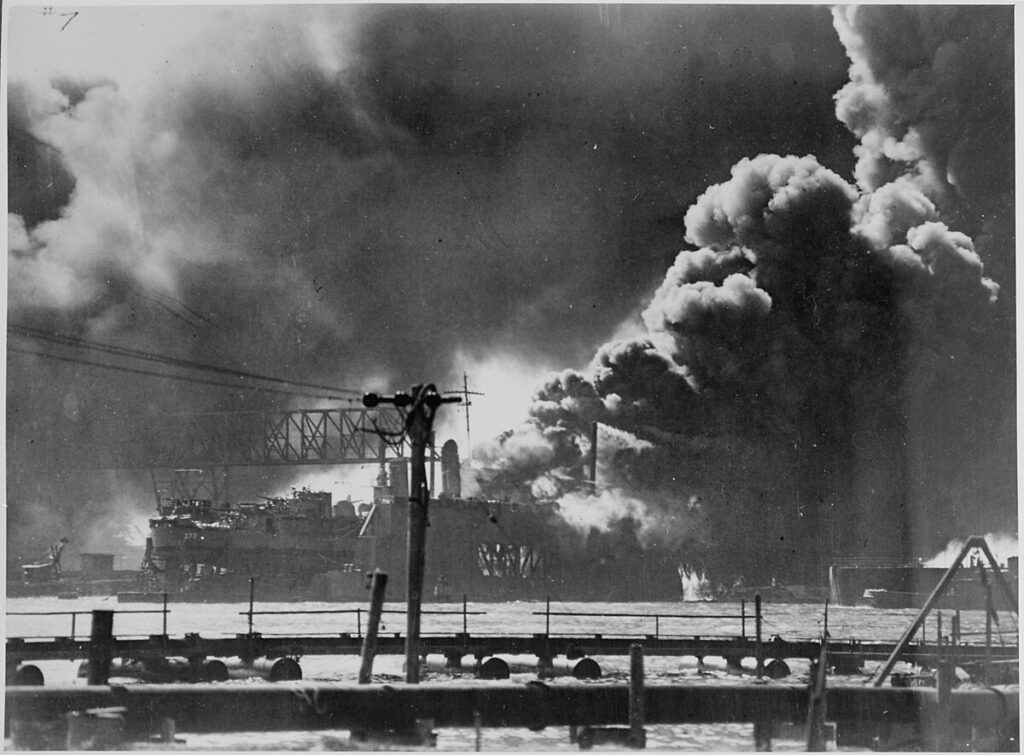
World War II: A defining moment in history that reshaped nations, tested the resilience of millions, and left a lasting legacy of courage, sacrifice, and the pursuit of peace.
World War II had a profound impact on Kauai, as it did on all of Hawaii. The island's strategic location in the Pacific made it a critical military outpost. Hanapepe and other areas were used for training and defense purposes, while the war effort brought new infrastructure and economic activity to the island.
After the war, Kauai began to transition from an agricultural economy to one centered on tourism. The island's natural beauty, from the dramatic cliffs of the Napali Coast to the pristine beaches of Poipu, attracted visitors from around the world. The rise of air travel made Kauai more accessible, and its reputation as a tranquil paradise solidified its place as a premier tourist destination.
Preserving the Past, Embracing the Future
Kauai's history is a story of resilience and adaptation. From its volcanic origins and early Polynesian settlers to its role in the Hawaiian Kingdom and its evolution into a modern destination, the island has continually found ways to balance change with preservation. Sacred sites, historical landmarks, and cultural practices are cherished and maintained, ensuring that Kauai's legacy endures for generations to come.
The island's unique spirit—a blend of natural beauty, cultural depth, and a deep sense of community—remains at the heart of Kauai's identity. Its history is not just a record of the past but a living narrative that continues to shape the lives of its people and inspire those who visit its shores.
Famous People from the Island of Kauai
The island of Kauai, renowned for its lush landscapes and tranquil beauty, is not only a natural wonder but also a place that has nurtured remarkable individuals who have made lasting contributions in various fields. From ancient Hawaiian royalty to contemporary artists and athletes, the people of Kauai embody the island's spirit of resilience, creativity, and aloha. Their legacies, whether rooted in tradition or driven by innovation, highlight the unique cultural and historical significance of the Garden Isle.
High Chief Kaumualii
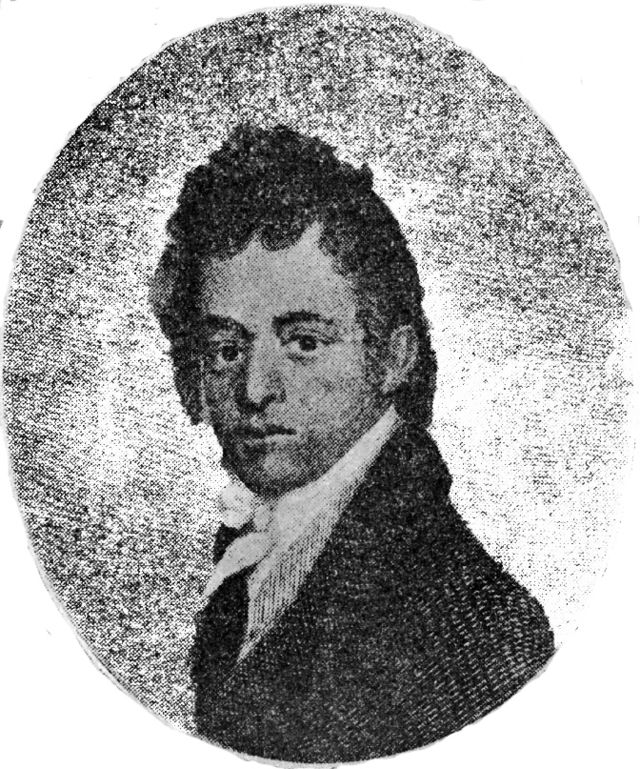
Tile on original is GEORGE PRINCE TAMOREE Son and heir of King Kaumualii of Kauai
Kaumualii, the last independent ruler of Kauai, holds a prominent place in Hawaiian history. Born around 1778, Kaumualii was the high chief of Kauai and Niihau during a time of significant change in the Hawaiian Islands. Unlike other islands that were unified through conquest by King Kamehameha I, Kauai maintained its independence under Kaumualii's leadership.
In 1810, Kaumualii peacefully negotiated with Kamehameha to cede Kauai to the Hawaiian Kingdom, avoiding a potentially devastating invasion. This agreement preserved the lives and livelihoods of Kauai's people while maintaining Kaumualii's authority as governor of the island. His diplomacy and wisdom are celebrated as examples of leadership that prioritized the well-being of his people.
Kaumualii's legacy endures through historical landmarks, such as his residence in Waimea, and cultural events that honor his contributions to Kauai's history. His life reflects the island's unique place in the broader narrative of Hawaiian unification and sovereignty.
Bethany Hamilton

Bethany Hamilton, a professional surfer and one of Kauai's most famous contemporary figures.
Bethany Hamilton, a professional surfer and inspirational speaker, is one of Kauai's most famous contemporary figures. Born in Lihue in 1990, Hamilton grew up surfing the island's renowned waves. At the age of 13, she survived a shark attack that resulted in the loss of her left arm. Despite this life-altering event, Hamilton's determination and resilience propelled her back into competitive surfing just months later.
Hamilton's story of overcoming adversity gained international attention, inspiring millions worldwide. Her autobiography, Soul Surfer, became a bestseller and was adapted into a feature film in 2011. Beyond her surfing achievements, Hamilton is a motivational speaker and advocate for people facing challenges, using her platform to promote faith, perseverance, and the power of positivity.
Lilo & Stitch Connection: Tia Carrere and Jason Scott Lee
While not born on Kauai, Tia Carrere and Jason Scott Lee have strong connections to the island through their roles in Disney's beloved animated film Lilo & Stitch. The movie, set on the island of Kauai, showcases the island's breathtaking scenery and rich cultural heritage. Carrere and Lee, both of Hawaiian descent, provided voices for key characters, bringing authenticity and heart to the story.
The film's depiction of Kauai's landscapes, traditions, and aloha spirit has made it a cherished representation of Hawaiian culture. Carrere and Lee's involvement underscores the importance of local voices in sharing Kauai's story with global audiences.
Bette Midler

Bette Midler, was born in Honolulu in 1945.
Bette Midler, affectionately known as "The Divine Miss M," has deep ties to Kauai, where she owns property and spends much of her time. Born in Honolulu, Midler's love for the Hawaiian Islands is evident in her philanthropic efforts and environmental advocacy. On Kauai, she has been involved in projects aimed at preserving the island's natural beauty and supporting local communities.
A renowned actress, singer, and comedian, Midler's illustrious career spans decades and includes numerous awards for her work in film, music, and theater. Her connection to Kauai adds a personal dimension to her legacy, as she uses her influence to give back to the island that has become her sanctuary.
Albert S. Wilcox

Albert Spencer Wilcox (1844-1919) was a businessman and politician in the Kingdom of Hawaii and Republic of Hawaii. He developed several sugar plantations in Hawaii, and became a large landholder.
Albert Spencer Wilcox was a prominent figure in Kauai's history during the late 19th and early 20th centuries. Born in 1844, Wilcox was a successful businessman and philanthropist who played a significant role in the island's development. He was deeply involved in agriculture, particularly in the sugarcane industry, which was a cornerstone of Kauai's economy during that era.
Wilcox's contributions extended beyond business. He and his wife, Emma Kauikeolani Napoleon Mahelona Wilcox, supported education and healthcare initiatives, including the establishment of schools and hospitals on Kauai. The Wilcox Memorial Hospital, named in his honor, remains one of the island's key healthcare facilities.
Paul Theroux

Author Paul Theroux at the Chicago Public Library during his book tour for Ghost Train to the Eastern Star. Sep 25th 2008
Albert Spencer Wilcox was a prominent figure in Kauai's history during the late 19th and early 20th centuries. Born in 1844, Wilcox was a successful businessman and philanthropist who played a significant role in the island's development. He was deeply involved in agriculture, particularly in the sugarcane industry, which was a cornerstone of Kauai's economy during that era.
Wilcox's contributions extended beyond business. He and his wife, Emma Kauikeolani Napoleon Mahelona Wilcox, supported education and healthcare initiatives, including the establishment of schools and hospitals on Kauai. The Wilcox Memorial Hospital, named in his honor, remains one of the island's key healthcare facilities.
Bruno Mars Connection
While Bruno Mars himself was born in Honolulu, his family has ties to Kauai, and the island's influence is evident in his music and persona. Known for his chart-topping hits and dynamic performances, Mars embodies the aloha spirit in his artistry and global appeal. His connection to Kauai highlights the island's role in shaping the creative talents of Hawaii's people.
Napali Coast
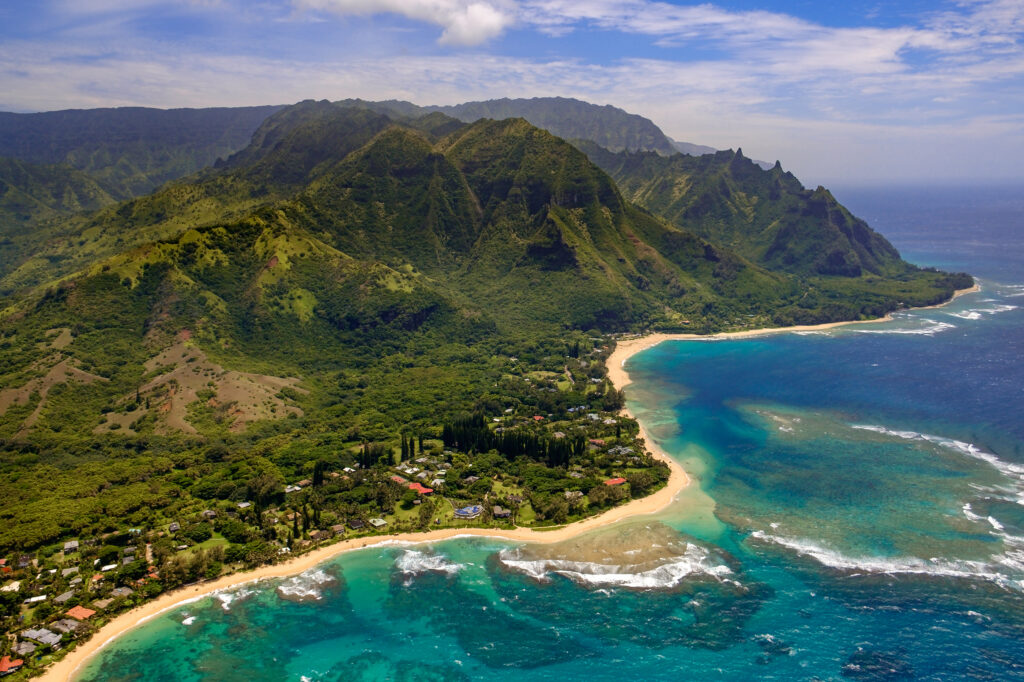
Aerial landscape view of shoreline at Na Pali coast Kauai Hawaii USA
The Napali Coast is one of Kauai's most iconic and breathtaking landmarks. Stretching along the island's northwestern shore, this 17-mile coastline is defined by towering sea cliffs, cascading waterfalls, and lush valleys that descend dramatically into the Pacific Ocean. The rugged terrain makes the Napali Coast inaccessible by road, preserving its wild and untamed beauty.
Visitors can explore the Napali Coast through hiking, boating, or helicopter tours. The Kalalau Trail, a challenging 11-mile trek, offers intrepid adventurers unparalleled views of the coastline and access to secluded beaches like Kalalau Beach. Alternatively, boat and kayak tours provide a unique perspective of the cliffs, allowing visitors to discover sea caves and hidden coves. Helicopter rides offer a bird's-eye view of this stunning landscape, revealing the full grandeur of Kauai's natural wonders.
Waimea Canyon
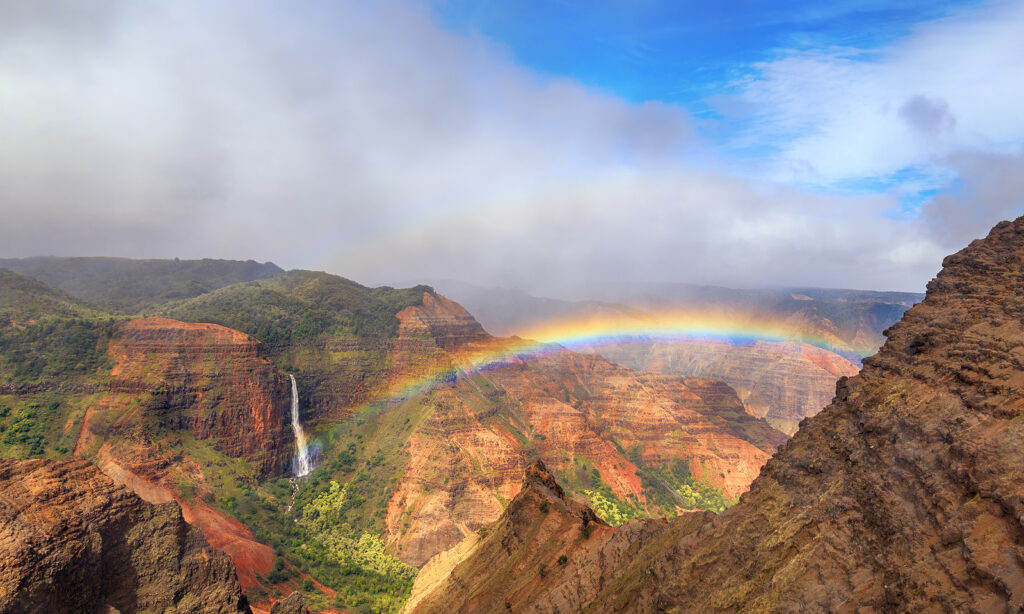
Rainbow over Waimea Canyon in Kauai, Hawaii
Often called the "Grand Canyon of the Pacific," Waimea Canyon is a geological marvel that stretches 14 miles long, one mile wide, and over 3,600 feet deep. Located on Kauai's west side, this canyon was formed by the erosive forces of the Waimea River and periodic volcanic activity. Its vibrant red and brown cliffs are interspersed with green vegetation, creating a striking contrast with the shifting sunlight.
Visitors to Waimea Canyon can explore its beauty through a network of hiking trails, scenic lookouts, and guided tours. Popular viewpoints like Pu'u o Kila Lookout and Waimea Canyon Lookout offer panoramic vistas of the canyon's rugged terrain and cascading waterfalls, including the dramatic Waipo'o Falls.
Wailua River and Fern Grotto
The Wailua River, one of Hawaii's few navigable rivers, winds through Kauai's lush landscapes, offering a serene way to explore the island's interior. This sacred river was once a key site for Hawaiian royalty, who built temples and other structures along its banks.
One of the river's most enchanting attractions is the Fern Grotto, a natural amphitheater draped in hanging ferns. Accessible by boat tour, the grotto is a popular site for weddings and cultural ceremonies, thanks to its tranquil ambiance and natural beauty. The Wailua River also provides access to waterfalls such as Opaeka'a Falls and Wailua Falls, both of which are must-see stops for visitors.
Hanalei Valley and Hanalei Bay
Hanalei Valley, located on Kauai's north shore, is a verdant expanse of taro fields surrounded by steep mountains and waterfalls. This area has been cultivated for centuries, preserving traditional Hawaiian agricultural practices and showcasing the island's rich cultural heritage. The Hanalei Valley Lookout provides a stunning view of this picturesque landscape, offering a glimpse into Kauai's farming history.
Adjacent to the valley is Hanalei Bay, a crescent-shaped bay with calm waters and soft sands. It is one of the most beautiful beaches on Kauai, offering opportunities for swimming, paddleboarding, and kayaking. The serene atmosphere of Hanalei Bay makes it a favorite destination for visitors seeking relaxation and natural beauty.
Kokee State Park
Kokee State Park, located in the uplands of Kauai, encompasses more than 4,000 acres of forests, cliffs, and valleys. The park is renowned for its hiking trails, which range from leisurely walks to challenging treks that traverse the island's rugged terrain. Trails like the Alakai Swamp Trail lead to unique ecosystems, while others, such as the Pihea Trail, offer panoramic views of the Kalalau Valley.
Kokee State Park is also a haven for birdwatchers, as it is home to several endemic Hawaiian bird species. The park's natural beauty and cooler climate provide a refreshing escape for those looking to immerse themselves in Kauai's wilderness.
Kokee State Park
Kokee State Park, located in the uplands of Kauai, encompasses more than 4,000 acres of forests, cliffs, and valleys. The park is renowned for its hiking trails, which range from leisurely walks to challenging treks that traverse the island's rugged terrain. Trails like the Alakai Swamp Trail lead to unique ecosystems, while others, such as the Pihea Trail, offer panoramic views of the Kalalau Valley.
Kokee State Park is also a haven for birdwatchers, as it is home to several endemic Hawaiian bird species. The park's natural beauty and cooler climate provide a refreshing escape for those looking to immerse themselves in Kauai's wilderness.
Spouting Horn
Located on Kauai's southern shore near Poipu, Spouting Horn is a natural blowhole that shoots water into the air with a dramatic hissing sound. This phenomenon occurs as waves rush into a lava tube and are forced upward through a narrow opening. Spouting Horn is particularly mesmerizing during high tide, when the water jets can reach impressive heights.
According to Hawaiian legend, Spouting Horn is protected by a mythical lizard that guards the coastline. This site is not only a geological wonder but also a place of cultural significance, reflecting the island's rich mythology.
Famous Beaches on Kauai
Poipu Beach
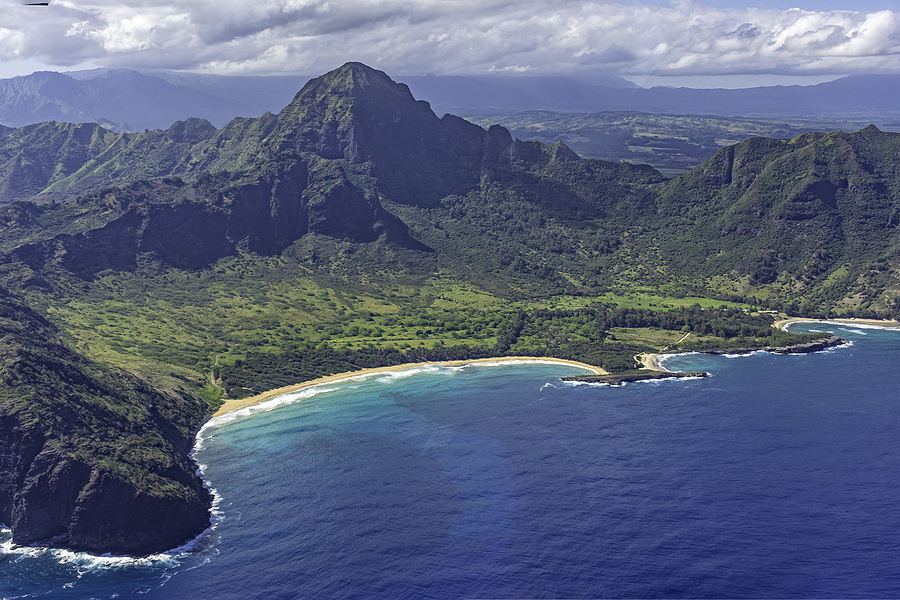
Aerial view of the Kauai south coast showing mountains beach and rugged coastline near Poipu Kauai Hawaii USA
Poipu Beach, located on Kauai's sunny south shore, is a family-friendly destination known for its golden sands and crystal-clear waters. The beach is divided into two crescent-shaped sections, separated by a sandbar that provides a sheltered swimming area for children. Poipu Beach is also a prime spot for snorkeling, with vibrant coral reefs teeming with tropical fish and sea turtles.
In addition to its natural beauty, Poipu Beach offers amenities such as picnic areas, restrooms, and nearby restaurants, making it a convenient and enjoyable destination for visitors of all ages.
Polihale State Park
Polihale State Park, located on Kauai's westernmost shore, is home to the island's longest beach. This remote stretch of white sand spans 17 miles, offering a sense of solitude and serenity that is unmatched. The beach is bordered by towering dunes and the dramatic cliffs of the Napali Coast, creating a breathtaking backdrop for sunsets and stargazing.
While Polihale's waters can be rough, the beach's natural beauty and seclusion make it a memorable destination for those seeking a true escape.
Ke'e Beach
Ke'e Beach, located at the end of the Kuhio Highway, marks the starting point of the Kalalau Trail along the Napali Coast. This picturesque beach is framed by lush cliffs and offers calm, clear waters for snorkeling and swimming during the summer months.
Ke'e Beach is also a place of cultural significance, as it is believed to be the birthplace of hula. Visitors can feel a deep connection to Kauai's traditions and natural splendor while enjoying the serene beauty of this north shore gem.
Shipwreck Beach
Shipwreck Beach, located near Poipu, is a strikingly beautiful stretch of coastline known for its rugged cliffs and golden sands. The beach is named after an old shipwreck that once rested on its shore, though the remains are no longer visible. Today, the beach is popular for surfing, bodyboarding, and hiking along the nearby Maha'ulepu Heritage Trail, which offers stunning views of the coastline.
While Shipwreck Beach's strong currents make it less ideal for swimming, its dramatic scenery and adventurous spirit attract visitors looking to experience Kauai's untamed beauty.
Kauai's landmarks and beaches are a testament to the island's unparalleled natural beauty and cultural depth. Each site offers a unique perspective on the Garden Isle, inviting visitors to connect with its history, mythology, and breathtaking landscapes.